English 1120D Essay: Social Mobilization of Race Analysis
VerifiedAdded on 2022/08/13
|11
|2872
|20
Essay
AI Summary
This essay delves into the complex issue of racial discrimination and its social mobilization, examining how race is constructed and perpetuated within society. The analysis centers on two key literary works: Toni Morrison's "The Bluest Eye" and Nisha Eswaran's "Show me Love: On Sexuality and being a lonely Brown Girl." The essay explores how racial biases, stemming from colonial legacies and societal norms, manifest in these texts, affecting the characters' experiences and identities. It highlights the internalization of racial discrimination within marginalized communities and the impact on self-perception and societal roles. Through a detailed examination of these texts, the essay argues that racial discrimination continues to be a pervasive issue in the 21st century, influencing social, political, and economic spheres. The essay also references secondary sources to provide a comprehensive understanding of the topic and its implications.
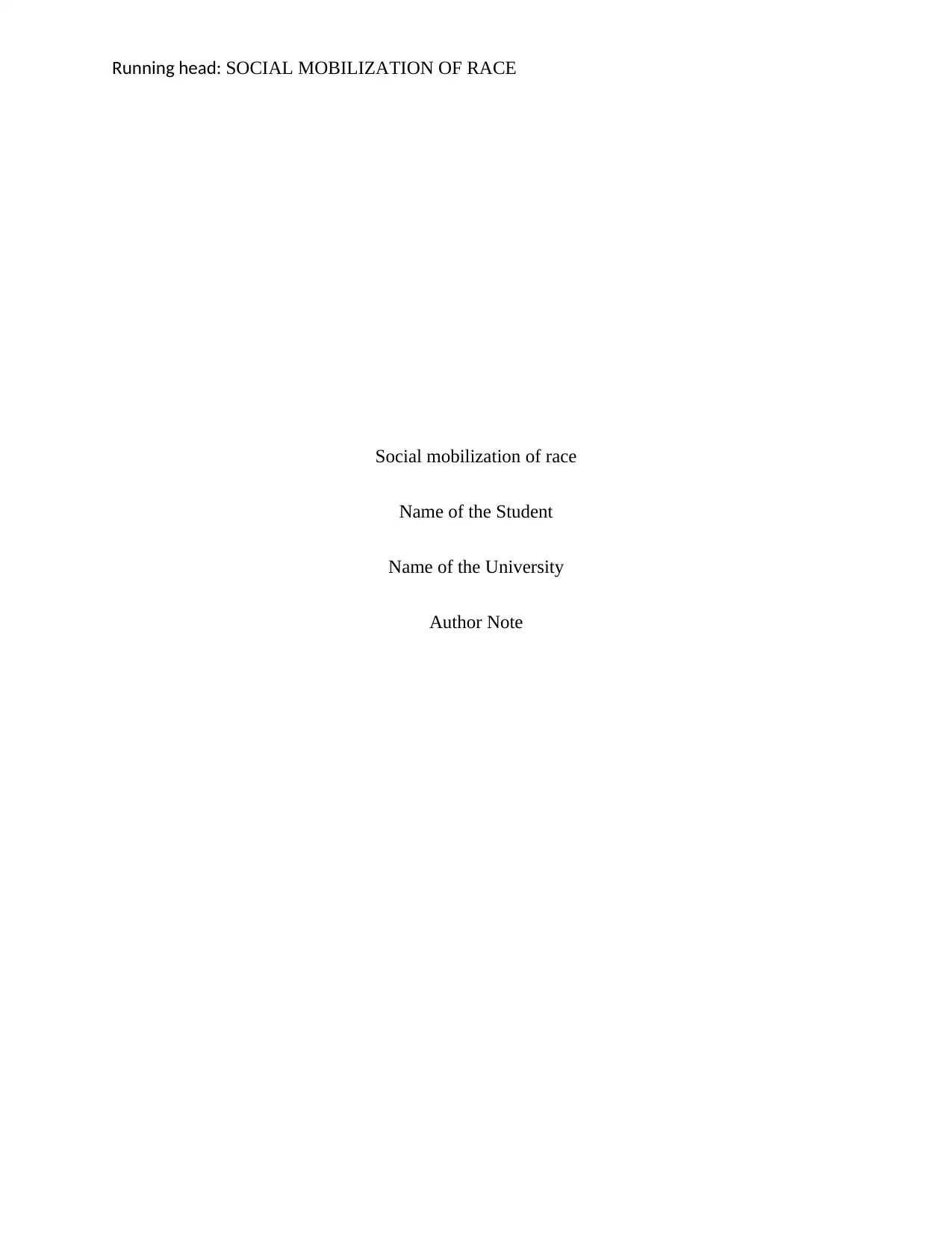
Running head: SOCIAL MOBILIZATION OF RACE
Social mobilization of race
Name of the Student
Name of the University
Author Note
Social mobilization of race
Name of the Student
Name of the University
Author Note
Paraphrase This Document
Need a fresh take? Get an instant paraphrase of this document with our AI Paraphraser
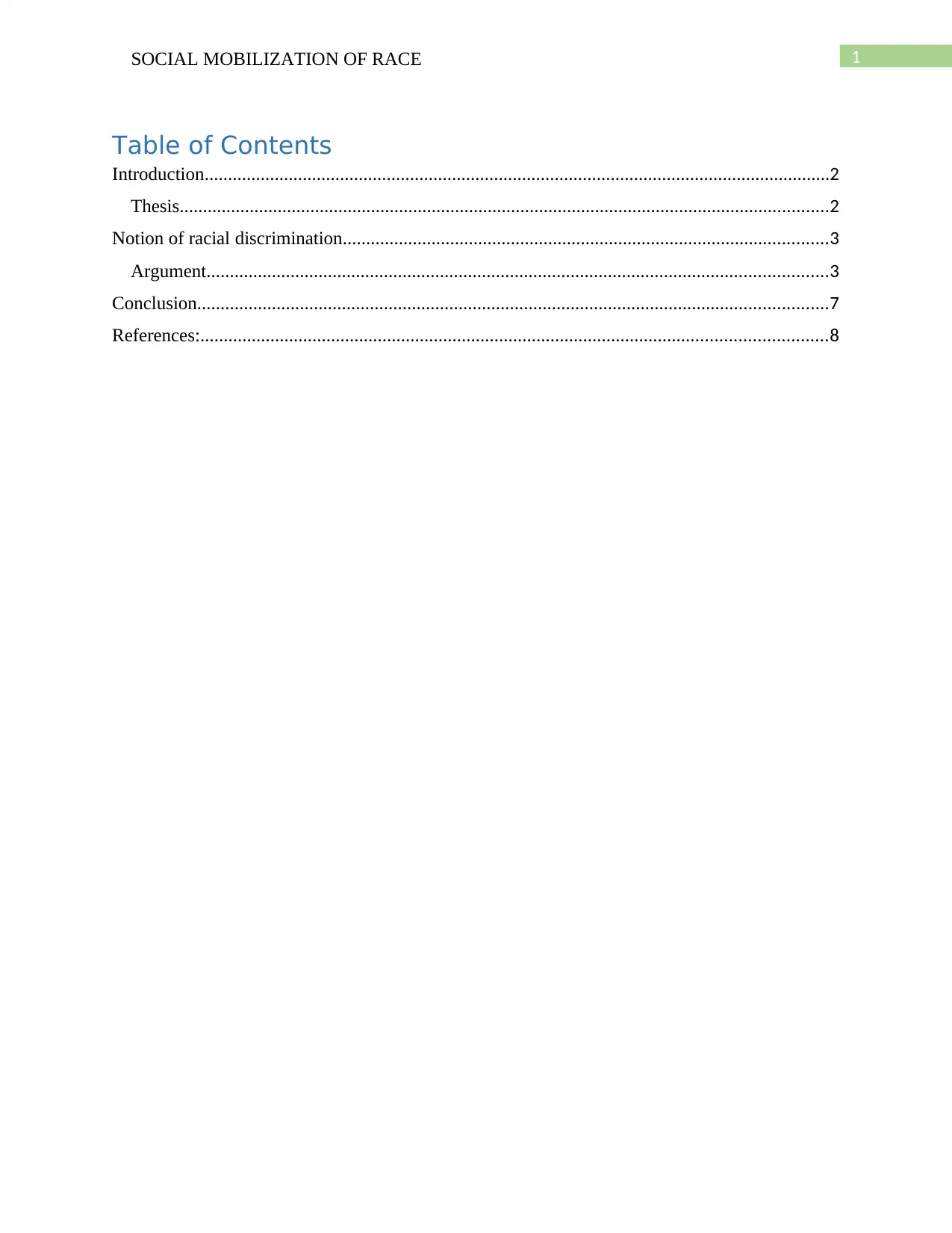
1SOCIAL MOBILIZATION OF RACE
Table of Contents
Introduction......................................................................................................................................2
Thesis...........................................................................................................................................2
Notion of racial discrimination........................................................................................................3
Argument.....................................................................................................................................3
Conclusion.......................................................................................................................................7
References:......................................................................................................................................8
Table of Contents
Introduction......................................................................................................................................2
Thesis...........................................................................................................................................2
Notion of racial discrimination........................................................................................................3
Argument.....................................................................................................................................3
Conclusion.......................................................................................................................................7
References:......................................................................................................................................8

2SOCIAL MOBILIZATION OF RACE
Introduction
Since the dawn of human civilization, the individuals are required to stay in communities
and societies. The structuring of such societies is based on the shared cultural heritage of such
people and the various other sociological aspects which are found to be common to them (Lauren
2018). For instance, the people living in a particular group are found to speak the same language,
eat the same food, wear similar kinds of dresses and follow the same religious doctrine.
However, there is a significant presence of discriminations within such societies which separates
one individual from that of another (Agan and Starr 2018). Such discriminations can be in the
form of racial discrimination, gender discrimination or even that of class or stature
discrimination. The issue of racial mobilization have always occupied a concerning position in
the society (Russell et al. 2018). Racial discrimination is present in the community because of
the manner in which the other individuals of the society perceive the ‘others’. (Eswaran 2018).
As a result of this, the ‘black’ skin toned people have usually been accorded a secondary role in
the society while their ‘white’ counterparts have been treated with more respect and reverence.
The purpose of this paper is to understand the issue of racial discrimination as it is present in the
society. In this context, two sources would be taken in to consideration, that is the “Bluest Eye”
as written by Toni Morrison and that of “Show me Love: On sexuality and being a lonely Brown
Girl” by Nisha Eswaran.
Thesis
The purpose of this research paper is to understand the issue of racial mobilization as done
by the society and its norms by analysing two important texts such as the “Bluest Eyes” as
written by Toni Morrison and the “Show me Love: On Sexuality and being a lonely Brown Girl”
as written by Nisha Eswaran. The racial instances which can be observed to be present in these
Introduction
Since the dawn of human civilization, the individuals are required to stay in communities
and societies. The structuring of such societies is based on the shared cultural heritage of such
people and the various other sociological aspects which are found to be common to them (Lauren
2018). For instance, the people living in a particular group are found to speak the same language,
eat the same food, wear similar kinds of dresses and follow the same religious doctrine.
However, there is a significant presence of discriminations within such societies which separates
one individual from that of another (Agan and Starr 2018). Such discriminations can be in the
form of racial discrimination, gender discrimination or even that of class or stature
discrimination. The issue of racial mobilization have always occupied a concerning position in
the society (Russell et al. 2018). Racial discrimination is present in the community because of
the manner in which the other individuals of the society perceive the ‘others’. (Eswaran 2018).
As a result of this, the ‘black’ skin toned people have usually been accorded a secondary role in
the society while their ‘white’ counterparts have been treated with more respect and reverence.
The purpose of this paper is to understand the issue of racial discrimination as it is present in the
society. In this context, two sources would be taken in to consideration, that is the “Bluest Eye”
as written by Toni Morrison and that of “Show me Love: On sexuality and being a lonely Brown
Girl” by Nisha Eswaran.
Thesis
The purpose of this research paper is to understand the issue of racial mobilization as done
by the society and its norms by analysing two important texts such as the “Bluest Eyes” as
written by Toni Morrison and the “Show me Love: On Sexuality and being a lonely Brown Girl”
as written by Nisha Eswaran. The racial instances which can be observed to be present in these
⊘ This is a preview!⊘
Do you want full access?
Subscribe today to unlock all pages.

Trusted by 1+ million students worldwide

3SOCIAL MOBILIZATION OF RACE
two texts have been analysed in the context of the present world scenario. The aim is to examine
the perpetuation of such racial discrimination even in the twenty first century.
Notion of racial discrimination
Racial discrimination signifies the differences which are created within the individuals of the
society based on their skin colour (Banerjee and Eccles 2019). This form of racial distinction has
its origin in the colonial period. From the fifteenth century itself, the advanced countries of the
world, primarily those belonging to the European continent, tried to expand their base of
operations. They wanted to spread their marketing production and manufacturing in other areas
of the world, with the intention of earning a higher margin of profit. In this regard, they started to
colonize the under developed and developing nations of the Asian and African continent due to
the reason that they had a huge reserve of natural rescores and human capital (Gavin et al. 2018).
However, this colonizing intention had to be justified by the imperial masters. They did
so by propounding the notion that they are racially superior to the ‘black’ ethnic population of
the colonized countries. They based their justification on the fact that the countries of the
European continent were structured in a civilized manner while the natives of the colonized
nations were not organized in a formal sense (Mouzon et al. 2017). Thus, the ‘white’ ethnic
population have of the society started to colonize the developing areas of the world in the hopes
of exploiting them against the back drop of racial discrimination.
Argument
The issues of racial discrimination have been explained in many scholarly writings since the
advent of the colonising era. The character of the white colonizers, the nature of self-doubt as
faced by the black ethnic population and the manner in which racial discrimination was
two texts have been analysed in the context of the present world scenario. The aim is to examine
the perpetuation of such racial discrimination even in the twenty first century.
Notion of racial discrimination
Racial discrimination signifies the differences which are created within the individuals of the
society based on their skin colour (Banerjee and Eccles 2019). This form of racial distinction has
its origin in the colonial period. From the fifteenth century itself, the advanced countries of the
world, primarily those belonging to the European continent, tried to expand their base of
operations. They wanted to spread their marketing production and manufacturing in other areas
of the world, with the intention of earning a higher margin of profit. In this regard, they started to
colonize the under developed and developing nations of the Asian and African continent due to
the reason that they had a huge reserve of natural rescores and human capital (Gavin et al. 2018).
However, this colonizing intention had to be justified by the imperial masters. They did
so by propounding the notion that they are racially superior to the ‘black’ ethnic population of
the colonized countries. They based their justification on the fact that the countries of the
European continent were structured in a civilized manner while the natives of the colonized
nations were not organized in a formal sense (Mouzon et al. 2017). Thus, the ‘white’ ethnic
population have of the society started to colonize the developing areas of the world in the hopes
of exploiting them against the back drop of racial discrimination.
Argument
The issues of racial discrimination have been explained in many scholarly writings since the
advent of the colonising era. The character of the white colonizers, the nature of self-doubt as
faced by the black ethnic population and the manner in which racial discrimination was
Paraphrase This Document
Need a fresh take? Get an instant paraphrase of this document with our AI Paraphraser
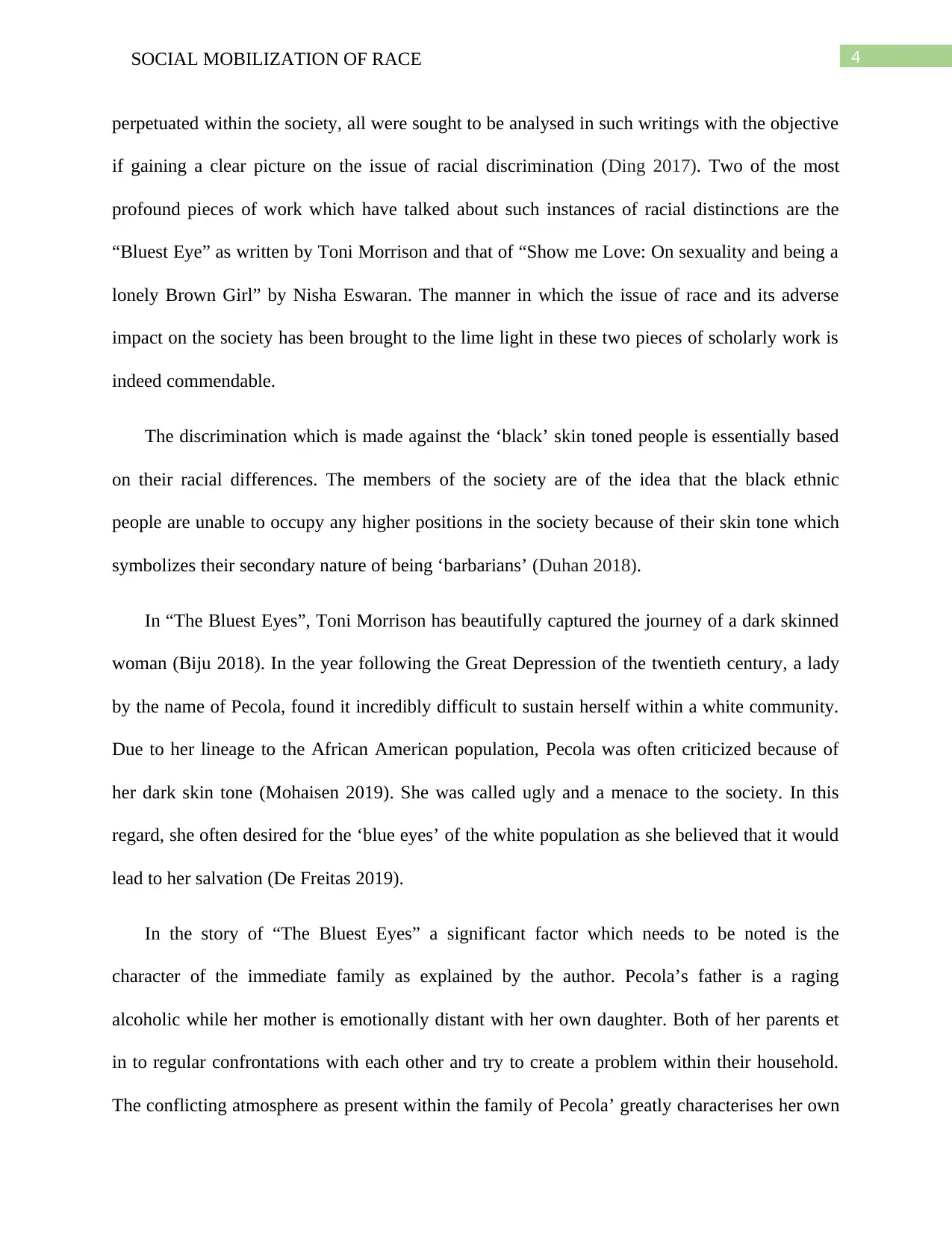
4SOCIAL MOBILIZATION OF RACE
perpetuated within the society, all were sought to be analysed in such writings with the objective
if gaining a clear picture on the issue of racial discrimination (Ding 2017). Two of the most
profound pieces of work which have talked about such instances of racial distinctions are the
“Bluest Eye” as written by Toni Morrison and that of “Show me Love: On sexuality and being a
lonely Brown Girl” by Nisha Eswaran. The manner in which the issue of race and its adverse
impact on the society has been brought to the lime light in these two pieces of scholarly work is
indeed commendable.
The discrimination which is made against the ‘black’ skin toned people is essentially based
on their racial differences. The members of the society are of the idea that the black ethnic
people are unable to occupy any higher positions in the society because of their skin tone which
symbolizes their secondary nature of being ‘barbarians’ (Duhan 2018).
In “The Bluest Eyes”, Toni Morrison has beautifully captured the journey of a dark skinned
woman (Biju 2018). In the year following the Great Depression of the twentieth century, a lady
by the name of Pecola, found it incredibly difficult to sustain herself within a white community.
Due to her lineage to the African American population, Pecola was often criticized because of
her dark skin tone (Mohaisen 2019). She was called ugly and a menace to the society. In this
regard, she often desired for the ‘blue eyes’ of the white population as she believed that it would
lead to her salvation (De Freitas 2019).
In the story of “The Bluest Eyes” a significant factor which needs to be noted is the
character of the immediate family as explained by the author. Pecola’s father is a raging
alcoholic while her mother is emotionally distant with her own daughter. Both of her parents et
in to regular confrontations with each other and try to create a problem within their household.
The conflicting atmosphere as present within the family of Pecola’ greatly characterises her own
perpetuated within the society, all were sought to be analysed in such writings with the objective
if gaining a clear picture on the issue of racial discrimination (Ding 2017). Two of the most
profound pieces of work which have talked about such instances of racial distinctions are the
“Bluest Eye” as written by Toni Morrison and that of “Show me Love: On sexuality and being a
lonely Brown Girl” by Nisha Eswaran. The manner in which the issue of race and its adverse
impact on the society has been brought to the lime light in these two pieces of scholarly work is
indeed commendable.
The discrimination which is made against the ‘black’ skin toned people is essentially based
on their racial differences. The members of the society are of the idea that the black ethnic
people are unable to occupy any higher positions in the society because of their skin tone which
symbolizes their secondary nature of being ‘barbarians’ (Duhan 2018).
In “The Bluest Eyes”, Toni Morrison has beautifully captured the journey of a dark skinned
woman (Biju 2018). In the year following the Great Depression of the twentieth century, a lady
by the name of Pecola, found it incredibly difficult to sustain herself within a white community.
Due to her lineage to the African American population, Pecola was often criticized because of
her dark skin tone (Mohaisen 2019). She was called ugly and a menace to the society. In this
regard, she often desired for the ‘blue eyes’ of the white population as she believed that it would
lead to her salvation (De Freitas 2019).
In the story of “The Bluest Eyes” a significant factor which needs to be noted is the
character of the immediate family as explained by the author. Pecola’s father is a raging
alcoholic while her mother is emotionally distant with her own daughter. Both of her parents et
in to regular confrontations with each other and try to create a problem within their household.
The conflicting atmosphere as present within the family of Pecola’ greatly characterises her own
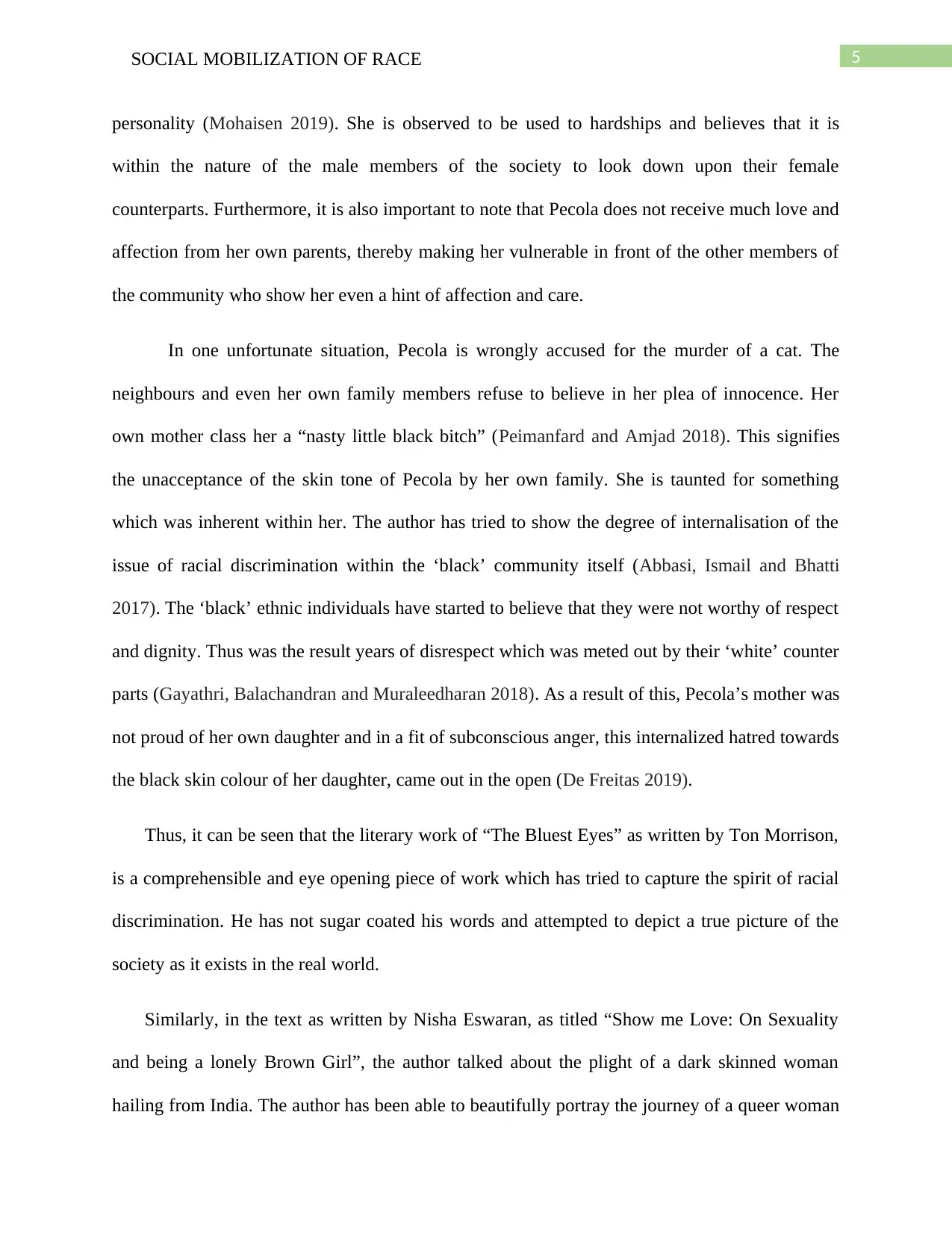
5SOCIAL MOBILIZATION OF RACE
personality (Mohaisen 2019). She is observed to be used to hardships and believes that it is
within the nature of the male members of the society to look down upon their female
counterparts. Furthermore, it is also important to note that Pecola does not receive much love and
affection from her own parents, thereby making her vulnerable in front of the other members of
the community who show her even a hint of affection and care.
In one unfortunate situation, Pecola is wrongly accused for the murder of a cat. The
neighbours and even her own family members refuse to believe in her plea of innocence. Her
own mother class her a “nasty little black bitch” (Peimanfard and Amjad 2018). This signifies
the unacceptance of the skin tone of Pecola by her own family. She is taunted for something
which was inherent within her. The author has tried to show the degree of internalisation of the
issue of racial discrimination within the ‘black’ community itself (Abbasi, Ismail and Bhatti
2017). The ‘black’ ethnic individuals have started to believe that they were not worthy of respect
and dignity. Thus was the result years of disrespect which was meted out by their ‘white’ counter
parts (Gayathri, Balachandran and Muraleedharan 2018). As a result of this, Pecola’s mother was
not proud of her own daughter and in a fit of subconscious anger, this internalized hatred towards
the black skin colour of her daughter, came out in the open (De Freitas 2019).
Thus, it can be seen that the literary work of “The Bluest Eyes” as written by Ton Morrison,
is a comprehensible and eye opening piece of work which has tried to capture the spirit of racial
discrimination. He has not sugar coated his words and attempted to depict a true picture of the
society as it exists in the real world.
Similarly, in the text as written by Nisha Eswaran, as titled “Show me Love: On Sexuality
and being a lonely Brown Girl”, the author talked about the plight of a dark skinned woman
hailing from India. The author has been able to beautifully portray the journey of a queer woman
personality (Mohaisen 2019). She is observed to be used to hardships and believes that it is
within the nature of the male members of the society to look down upon their female
counterparts. Furthermore, it is also important to note that Pecola does not receive much love and
affection from her own parents, thereby making her vulnerable in front of the other members of
the community who show her even a hint of affection and care.
In one unfortunate situation, Pecola is wrongly accused for the murder of a cat. The
neighbours and even her own family members refuse to believe in her plea of innocence. Her
own mother class her a “nasty little black bitch” (Peimanfard and Amjad 2018). This signifies
the unacceptance of the skin tone of Pecola by her own family. She is taunted for something
which was inherent within her. The author has tried to show the degree of internalisation of the
issue of racial discrimination within the ‘black’ community itself (Abbasi, Ismail and Bhatti
2017). The ‘black’ ethnic individuals have started to believe that they were not worthy of respect
and dignity. Thus was the result years of disrespect which was meted out by their ‘white’ counter
parts (Gayathri, Balachandran and Muraleedharan 2018). As a result of this, Pecola’s mother was
not proud of her own daughter and in a fit of subconscious anger, this internalized hatred towards
the black skin colour of her daughter, came out in the open (De Freitas 2019).
Thus, it can be seen that the literary work of “The Bluest Eyes” as written by Ton Morrison,
is a comprehensible and eye opening piece of work which has tried to capture the spirit of racial
discrimination. He has not sugar coated his words and attempted to depict a true picture of the
society as it exists in the real world.
Similarly, in the text as written by Nisha Eswaran, as titled “Show me Love: On Sexuality
and being a lonely Brown Girl”, the author talked about the plight of a dark skinned woman
hailing from India. The author has been able to beautifully portray the journey of a queer woman
⊘ This is a preview!⊘
Do you want full access?
Subscribe today to unlock all pages.

Trusted by 1+ million students worldwide
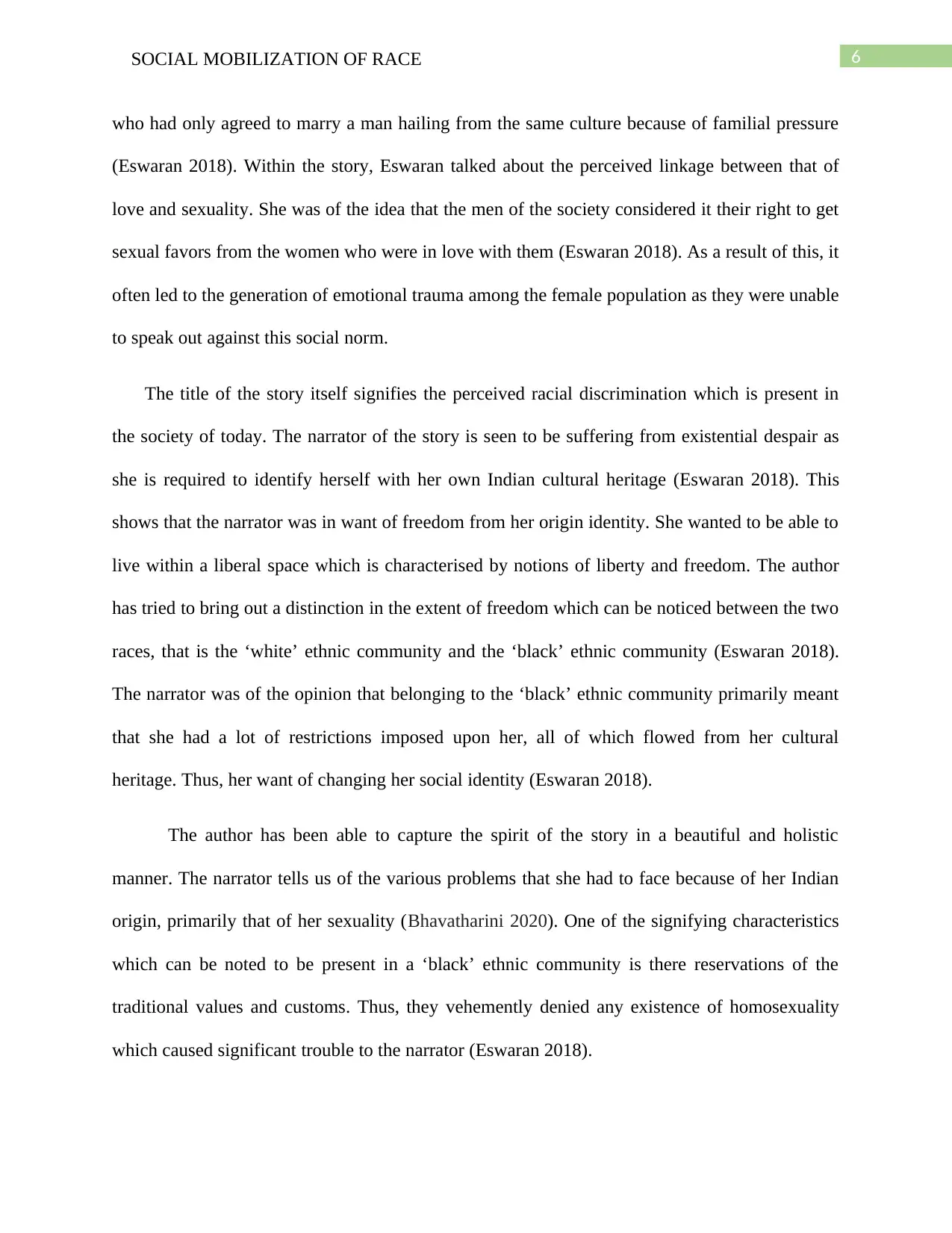
6SOCIAL MOBILIZATION OF RACE
who had only agreed to marry a man hailing from the same culture because of familial pressure
(Eswaran 2018). Within the story, Eswaran talked about the perceived linkage between that of
love and sexuality. She was of the idea that the men of the society considered it their right to get
sexual favors from the women who were in love with them (Eswaran 2018). As a result of this, it
often led to the generation of emotional trauma among the female population as they were unable
to speak out against this social norm.
The title of the story itself signifies the perceived racial discrimination which is present in
the society of today. The narrator of the story is seen to be suffering from existential despair as
she is required to identify herself with her own Indian cultural heritage (Eswaran 2018). This
shows that the narrator was in want of freedom from her origin identity. She wanted to be able to
live within a liberal space which is characterised by notions of liberty and freedom. The author
has tried to bring out a distinction in the extent of freedom which can be noticed between the two
races, that is the ‘white’ ethnic community and the ‘black’ ethnic community (Eswaran 2018).
The narrator was of the opinion that belonging to the ‘black’ ethnic community primarily meant
that she had a lot of restrictions imposed upon her, all of which flowed from her cultural
heritage. Thus, her want of changing her social identity (Eswaran 2018).
The author has been able to capture the spirit of the story in a beautiful and holistic
manner. The narrator tells us of the various problems that she had to face because of her Indian
origin, primarily that of her sexuality (Bhavatharini 2020). One of the signifying characteristics
which can be noted to be present in a ‘black’ ethnic community is there reservations of the
traditional values and customs. Thus, they vehemently denied any existence of homosexuality
which caused significant trouble to the narrator (Eswaran 2018).
who had only agreed to marry a man hailing from the same culture because of familial pressure
(Eswaran 2018). Within the story, Eswaran talked about the perceived linkage between that of
love and sexuality. She was of the idea that the men of the society considered it their right to get
sexual favors from the women who were in love with them (Eswaran 2018). As a result of this, it
often led to the generation of emotional trauma among the female population as they were unable
to speak out against this social norm.
The title of the story itself signifies the perceived racial discrimination which is present in
the society of today. The narrator of the story is seen to be suffering from existential despair as
she is required to identify herself with her own Indian cultural heritage (Eswaran 2018). This
shows that the narrator was in want of freedom from her origin identity. She wanted to be able to
live within a liberal space which is characterised by notions of liberty and freedom. The author
has tried to bring out a distinction in the extent of freedom which can be noticed between the two
races, that is the ‘white’ ethnic community and the ‘black’ ethnic community (Eswaran 2018).
The narrator was of the opinion that belonging to the ‘black’ ethnic community primarily meant
that she had a lot of restrictions imposed upon her, all of which flowed from her cultural
heritage. Thus, her want of changing her social identity (Eswaran 2018).
The author has been able to capture the spirit of the story in a beautiful and holistic
manner. The narrator tells us of the various problems that she had to face because of her Indian
origin, primarily that of her sexuality (Bhavatharini 2020). One of the signifying characteristics
which can be noted to be present in a ‘black’ ethnic community is there reservations of the
traditional values and customs. Thus, they vehemently denied any existence of homosexuality
which caused significant trouble to the narrator (Eswaran 2018).
Paraphrase This Document
Need a fresh take? Get an instant paraphrase of this document with our AI Paraphraser
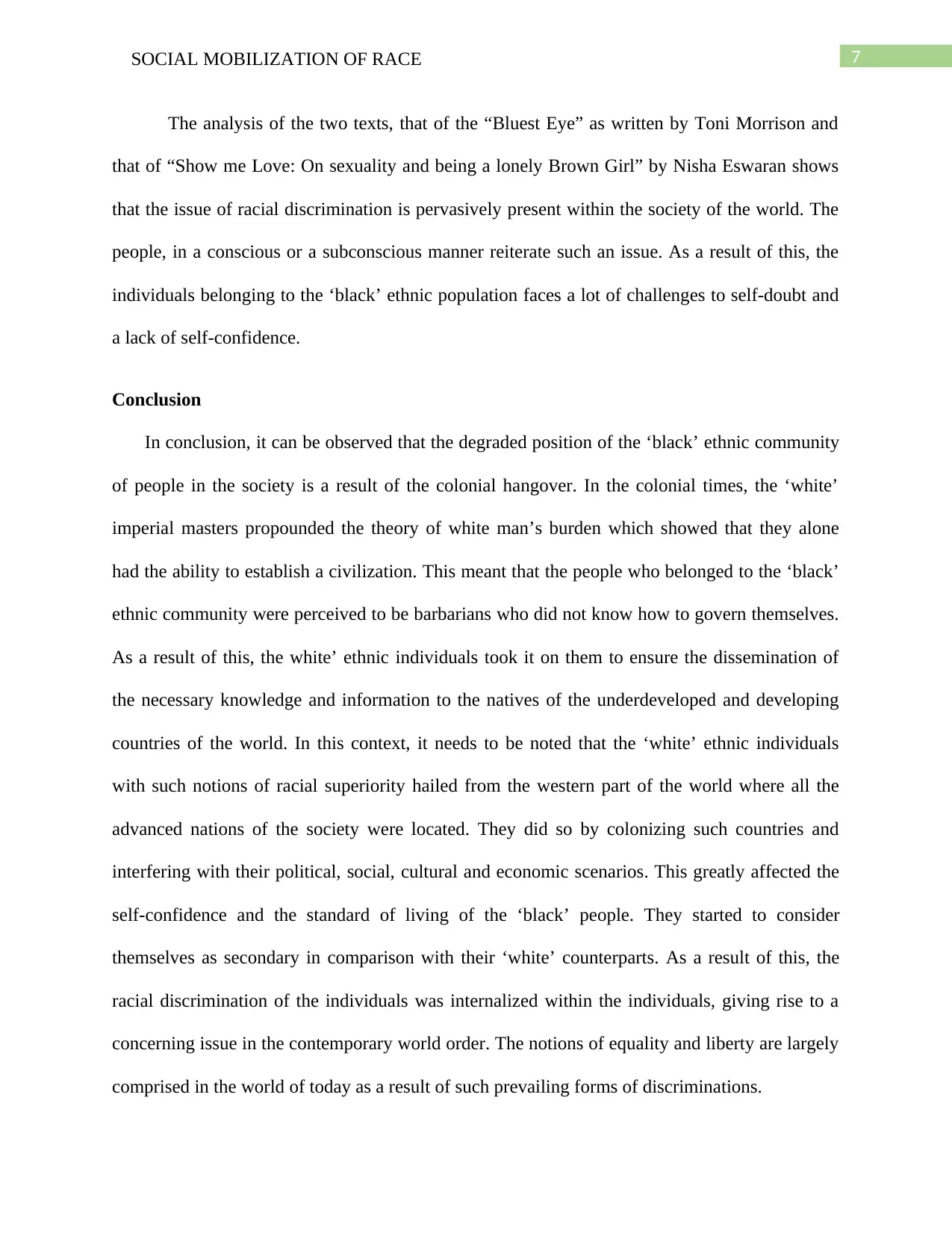
7SOCIAL MOBILIZATION OF RACE
The analysis of the two texts, that of the “Bluest Eye” as written by Toni Morrison and
that of “Show me Love: On sexuality and being a lonely Brown Girl” by Nisha Eswaran shows
that the issue of racial discrimination is pervasively present within the society of the world. The
people, in a conscious or a subconscious manner reiterate such an issue. As a result of this, the
individuals belonging to the ‘black’ ethnic population faces a lot of challenges to self-doubt and
a lack of self-confidence.
Conclusion
In conclusion, it can be observed that the degraded position of the ‘black’ ethnic community
of people in the society is a result of the colonial hangover. In the colonial times, the ‘white’
imperial masters propounded the theory of white man’s burden which showed that they alone
had the ability to establish a civilization. This meant that the people who belonged to the ‘black’
ethnic community were perceived to be barbarians who did not know how to govern themselves.
As a result of this, the white’ ethnic individuals took it on them to ensure the dissemination of
the necessary knowledge and information to the natives of the underdeveloped and developing
countries of the world. In this context, it needs to be noted that the ‘white’ ethnic individuals
with such notions of racial superiority hailed from the western part of the world where all the
advanced nations of the society were located. They did so by colonizing such countries and
interfering with their political, social, cultural and economic scenarios. This greatly affected the
self-confidence and the standard of living of the ‘black’ people. They started to consider
themselves as secondary in comparison with their ‘white’ counterparts. As a result of this, the
racial discrimination of the individuals was internalized within the individuals, giving rise to a
concerning issue in the contemporary world order. The notions of equality and liberty are largely
comprised in the world of today as a result of such prevailing forms of discriminations.
The analysis of the two texts, that of the “Bluest Eye” as written by Toni Morrison and
that of “Show me Love: On sexuality and being a lonely Brown Girl” by Nisha Eswaran shows
that the issue of racial discrimination is pervasively present within the society of the world. The
people, in a conscious or a subconscious manner reiterate such an issue. As a result of this, the
individuals belonging to the ‘black’ ethnic population faces a lot of challenges to self-doubt and
a lack of self-confidence.
Conclusion
In conclusion, it can be observed that the degraded position of the ‘black’ ethnic community
of people in the society is a result of the colonial hangover. In the colonial times, the ‘white’
imperial masters propounded the theory of white man’s burden which showed that they alone
had the ability to establish a civilization. This meant that the people who belonged to the ‘black’
ethnic community were perceived to be barbarians who did not know how to govern themselves.
As a result of this, the white’ ethnic individuals took it on them to ensure the dissemination of
the necessary knowledge and information to the natives of the underdeveloped and developing
countries of the world. In this context, it needs to be noted that the ‘white’ ethnic individuals
with such notions of racial superiority hailed from the western part of the world where all the
advanced nations of the society were located. They did so by colonizing such countries and
interfering with their political, social, cultural and economic scenarios. This greatly affected the
self-confidence and the standard of living of the ‘black’ people. They started to consider
themselves as secondary in comparison with their ‘white’ counterparts. As a result of this, the
racial discrimination of the individuals was internalized within the individuals, giving rise to a
concerning issue in the contemporary world order. The notions of equality and liberty are largely
comprised in the world of today as a result of such prevailing forms of discriminations.

8SOCIAL MOBILIZATION OF RACE
References:
Abbasi, Muhammad Ismail, and Shaheena Ayub Bhatti. "White Linguistic Violence and Black
Americans: A Textual Analysis of the Bluest Eye." Journal of Research in Social
Sciences 5.1 (2017): 135.
Agan, Amanda, and Sonja Starr. "Ban the box, criminal records, and racial discrimination: A
field experiment." The Quarterly Journal of Economics 133.1 (2018): 191-235.
Banerjee, Meeta, and Jacquelynne S. Eccles. "Perceived Racial Discrimination as a Context for
Parenting in African American and European American Youth." Handbook of Children and
Prejudice. Springer, Cham, 2019. 233-247.
Bhavatharini, Ms T. "Women On Colour: Theme Of Violence, Discrimination And
Empowerment." Studies in Indian Place Names 40.41 (2020): 49-54.
Biju, Vidhiya. "Social Barriers Revealed Out in Toni Morrison’s The Bluest Eye." (2018).
De Freitas, Sandra. "A Psychoanalytical Study on the Importance of Skin Tone in Toni
Morrison’s The Bluest Eye." (2019).
Ding, Zhirui. "Ecological Feminism in The Bluest Eyes." 2016 2nd International Conference on
Economics, Management Engineering and Education Technology (ICEMEET 2016).
Atlantis Press, 2017.
Duhan, Roshni. "Role of Women Novelists and Feminist Criticism in English Literature with
Special Reference to Toni Morrison’s the Bluest Eyes." IJASSH (2018).
References:
Abbasi, Muhammad Ismail, and Shaheena Ayub Bhatti. "White Linguistic Violence and Black
Americans: A Textual Analysis of the Bluest Eye." Journal of Research in Social
Sciences 5.1 (2017): 135.
Agan, Amanda, and Sonja Starr. "Ban the box, criminal records, and racial discrimination: A
field experiment." The Quarterly Journal of Economics 133.1 (2018): 191-235.
Banerjee, Meeta, and Jacquelynne S. Eccles. "Perceived Racial Discrimination as a Context for
Parenting in African American and European American Youth." Handbook of Children and
Prejudice. Springer, Cham, 2019. 233-247.
Bhavatharini, Ms T. "Women On Colour: Theme Of Violence, Discrimination And
Empowerment." Studies in Indian Place Names 40.41 (2020): 49-54.
Biju, Vidhiya. "Social Barriers Revealed Out in Toni Morrison’s The Bluest Eye." (2018).
De Freitas, Sandra. "A Psychoanalytical Study on the Importance of Skin Tone in Toni
Morrison’s The Bluest Eye." (2019).
Ding, Zhirui. "Ecological Feminism in The Bluest Eyes." 2016 2nd International Conference on
Economics, Management Engineering and Education Technology (ICEMEET 2016).
Atlantis Press, 2017.
Duhan, Roshni. "Role of Women Novelists and Feminist Criticism in English Literature with
Special Reference to Toni Morrison’s the Bluest Eyes." IJASSH (2018).
⊘ This is a preview!⊘
Do you want full access?
Subscribe today to unlock all pages.

Trusted by 1+ million students worldwide
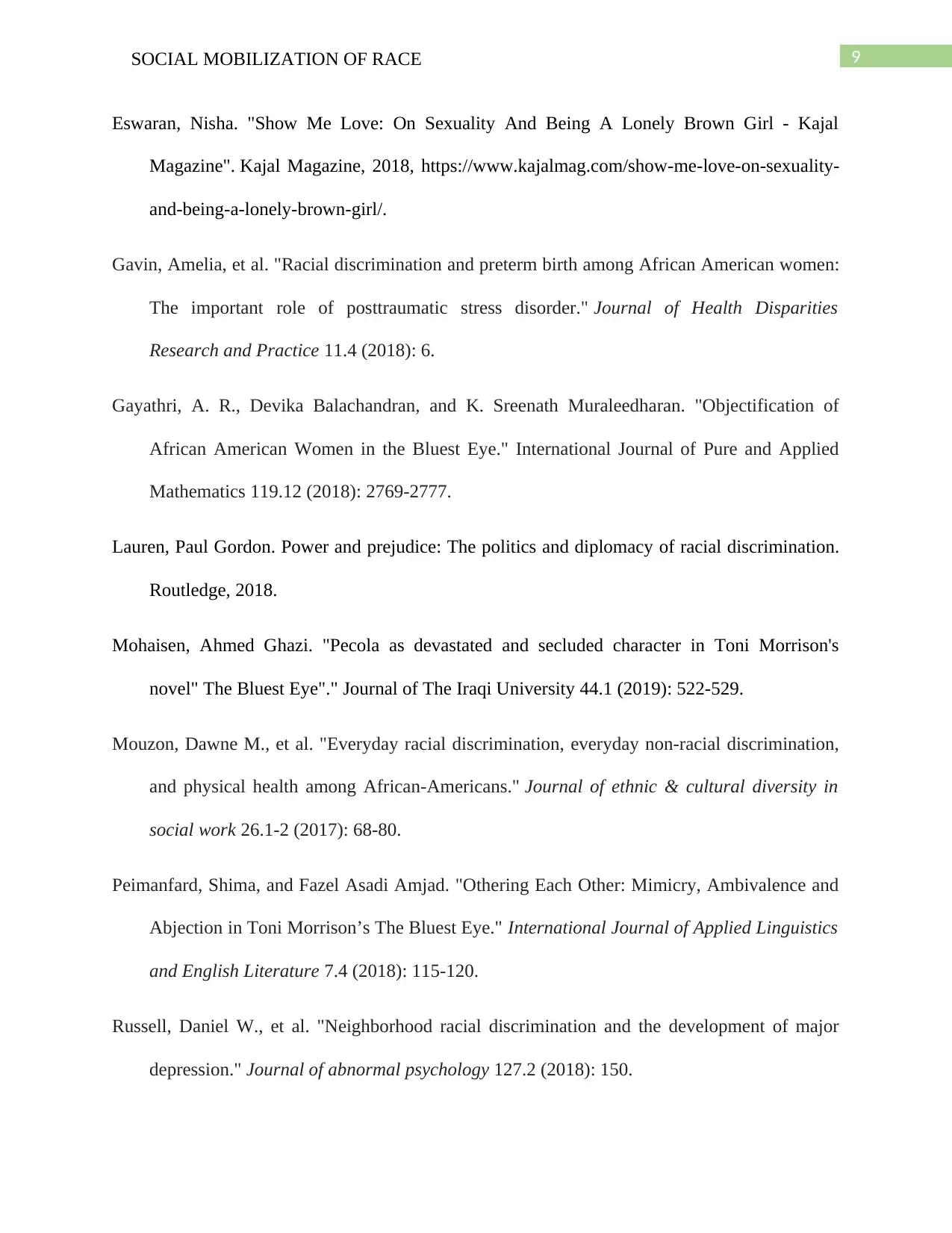
9SOCIAL MOBILIZATION OF RACE
Eswaran, Nisha. "Show Me Love: On Sexuality And Being A Lonely Brown Girl - Kajal
Magazine". Kajal Magazine, 2018, https://www.kajalmag.com/show-me-love-on-sexuality-
and-being-a-lonely-brown-girl/.
Gavin, Amelia, et al. "Racial discrimination and preterm birth among African American women:
The important role of posttraumatic stress disorder." Journal of Health Disparities
Research and Practice 11.4 (2018): 6.
Gayathri, A. R., Devika Balachandran, and K. Sreenath Muraleedharan. "Objectification of
African American Women in the Bluest Eye." International Journal of Pure and Applied
Mathematics 119.12 (2018): 2769-2777.
Lauren, Paul Gordon. Power and prejudice: The politics and diplomacy of racial discrimination.
Routledge, 2018.
Mohaisen, Ahmed Ghazi. "Pecola as devastated and secluded character in Toni Morrison's
novel" The Bluest Eye"." Journal of The Iraqi University 44.1 (2019): 522-529.
Mouzon, Dawne M., et al. "Everyday racial discrimination, everyday non-racial discrimination,
and physical health among African-Americans." Journal of ethnic & cultural diversity in
social work 26.1-2 (2017): 68-80.
Peimanfard, Shima, and Fazel Asadi Amjad. "Othering Each Other: Mimicry, Ambivalence and
Abjection in Toni Morrison’s The Bluest Eye." International Journal of Applied Linguistics
and English Literature 7.4 (2018): 115-120.
Russell, Daniel W., et al. "Neighborhood racial discrimination and the development of major
depression." Journal of abnormal psychology 127.2 (2018): 150.
Eswaran, Nisha. "Show Me Love: On Sexuality And Being A Lonely Brown Girl - Kajal
Magazine". Kajal Magazine, 2018, https://www.kajalmag.com/show-me-love-on-sexuality-
and-being-a-lonely-brown-girl/.
Gavin, Amelia, et al. "Racial discrimination and preterm birth among African American women:
The important role of posttraumatic stress disorder." Journal of Health Disparities
Research and Practice 11.4 (2018): 6.
Gayathri, A. R., Devika Balachandran, and K. Sreenath Muraleedharan. "Objectification of
African American Women in the Bluest Eye." International Journal of Pure and Applied
Mathematics 119.12 (2018): 2769-2777.
Lauren, Paul Gordon. Power and prejudice: The politics and diplomacy of racial discrimination.
Routledge, 2018.
Mohaisen, Ahmed Ghazi. "Pecola as devastated and secluded character in Toni Morrison's
novel" The Bluest Eye"." Journal of The Iraqi University 44.1 (2019): 522-529.
Mouzon, Dawne M., et al. "Everyday racial discrimination, everyday non-racial discrimination,
and physical health among African-Americans." Journal of ethnic & cultural diversity in
social work 26.1-2 (2017): 68-80.
Peimanfard, Shima, and Fazel Asadi Amjad. "Othering Each Other: Mimicry, Ambivalence and
Abjection in Toni Morrison’s The Bluest Eye." International Journal of Applied Linguistics
and English Literature 7.4 (2018): 115-120.
Russell, Daniel W., et al. "Neighborhood racial discrimination and the development of major
depression." Journal of abnormal psychology 127.2 (2018): 150.
Paraphrase This Document
Need a fresh take? Get an instant paraphrase of this document with our AI Paraphraser

10SOCIAL MOBILIZATION OF RACE
1 out of 11
Your All-in-One AI-Powered Toolkit for Academic Success.
+13062052269
info@desklib.com
Available 24*7 on WhatsApp / Email
![[object Object]](/_next/static/media/star-bottom.7253800d.svg)
Unlock your academic potential
Copyright © 2020–2025 A2Z Services. All Rights Reserved. Developed and managed by ZUCOL.